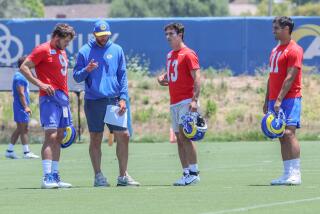300 Cheers for N. Korean Team
It was the North Korean cheerleaders who stole the show.
At the opening of the 14th Asian Games here Sunday, there were East Timorese athletes marking their newborn nation’s debut in the tournament and an Afghan delegation that had spent five days traveling from its ravaged homeland. There were fireworks, lasers, marching bands and special effects.
But nothing attracted as much attention as a cheering squad of 300 North Koreans, most of them attractive women in their 20s who waved tiny flags featuring North Korea’s red star.
This is the first time that North Korea has participated in an international sporting event in South Korea. But what is more remarkable than the northern nation’s 184 competing athletes is the presence of the North Korean fans who have come to cheer them on.
The estranged Koreas have held dozens of joint events over the last two years, ranging from circuses to family reunions. But this delegation of more than 600, including coaches and officials, is by far the largest from North Korea to come south since the end of the Korean War in 1953.
The historic occasion has spurred the breaking of many taboos. This is the first time the North Korean flag has been legally displayed in South Korea. The ferry that brought the fans Saturday after a 20-hour journey is the first North Korean passenger vessel to sail through South Korean waters and be moored at a South Korean port.
Docked on the outskirts of Pusan, the Mangyongbong 92 has quickly become a major tourist attraction. On Sunday, hundreds of South Koreans came to pose with babies and elderly parents for photographs of the vessel, which has a North Korean flag painted on its smokestack.
“I’m so happy they are here. It is a long time since the war. They are most welcome,” said Byon Oak Su, 74, who wore a traditional festive gown for the occasion.
The North Korean cheerleaders will take most of their meals and will sleep on the ferry under heavy security. Unlike other delegations, they will not tour Pusan or check out its restaurants and stores--thereby minimizing any chance that they might chat with ordinary South Koreans or dare to think about defecting.
“Once in a while, they come out and you can see them on the deck. Sometimes they wave at us,” said Kim Kwang Eul, 37, a curiosity seeker who was with a crowd waiting Sunday for a glimpse of the elusive North Koreans.
Kim said he understood why the North Koreans are being kept separate.
“We have such different lifestyles. If they were all of a sudden to see how South Koreans live, it might be a shock,” he said.
Even at the opening ceremony, the North Koreans were elusive, seated in a separate section surrounded by beefy black-clad South Korean security guards who shooed away representatives of the media and anyone else who came too close. Security has been so tight around the North Koreans that an official South Korean cheerleading squad had to cancel plans for joint cheering sessions and rallies.
The security has also reduced the South Korean paparazzi to using long lenses aimed at the ferry to capture the occasional shot.
The cheerleaders are not like their American counterparts. They wear modest, flowing silk gowns in the traditional Korean style, wave flags and sing songs. Some belong to a marching band, while others are university students or members of a youth movement of the Korean Workers’ Party.
South Korean television has speculated endlessly about the women, making coy references to the popular belief among South Korean men that women from the North are more attractive.
“Not only me. Everyone in North Korea is pretty,” one North Korean cheerleader said to a South Korean journalist who was able to shout a question.
Despite the barriers making it difficult for North and South Koreans to chat, the opening ceremony was replete with symbolic gestures of togetherness. As the crowd gave a thunderous standing ovation, northerners and southerners marched together in the ceremony. In a deft solution to protocol problems, a South Korean handball player and a North Korean soccer player together carried a banner known as the “unity flag,” which features a pale blue silhouette of the Korean peninsula.
Then, Olympic gold medalist Kye Sun Hui, a judo champion and one of the best-known female athletes in North Korea, ran around the track with South Korean judo gold medalist Ha Hyung Ju carrying the torch to launch the games.
“This torch symbolizes the historic meeting of the Koreas and tying the first knot toward unification,” Ha later told reporters.
One of the few northern athletes to talk to the media, the 7-foot-9-inch basketball player Ri Myong Hun echoed that observation, telling reporters, “North Korea wants reunification very much, and for that reason, North Korea took part in the Asian Games this time.”
In terms of participants, this tournament is the largest ever, with 44 delegations and 6,700 athletes.
Aside from the North Koreans, the most attention has been paid to the Afghans, who are participating for the first time in nearly 20 years and barely made it because of their difficulty in traveling outside Afghanistan. They have 25 athletes participating, including a female taekwondo adept who was banned from the sport under the now-deposed Taliban regime.
East Timor is the newest nation participating. The Palestinians also made a stir at the opening ceremony, as the only delegation carrying a photograph of their leader--Yasser Arafat.
The tournament runs through Oct. 14.
More to Read
Go beyond the scoreboard
Get the latest on L.A.'s teams in the daily Sports Report newsletter.
You may occasionally receive promotional content from the Los Angeles Times.






